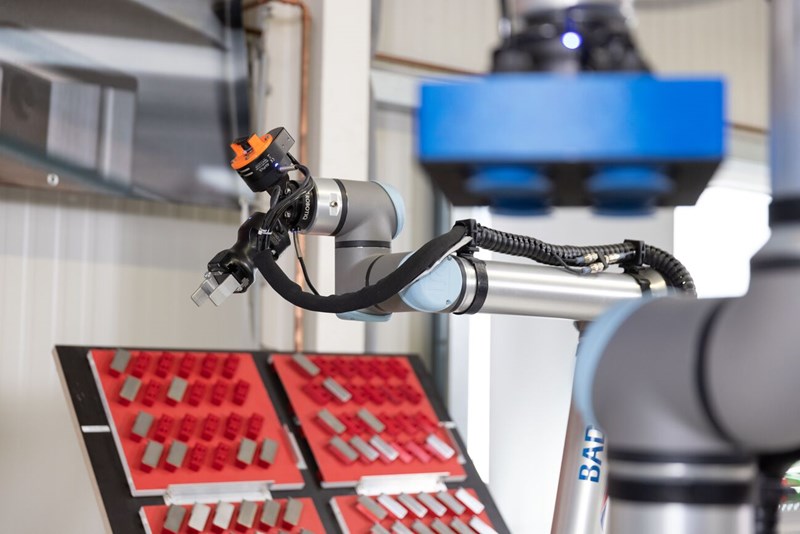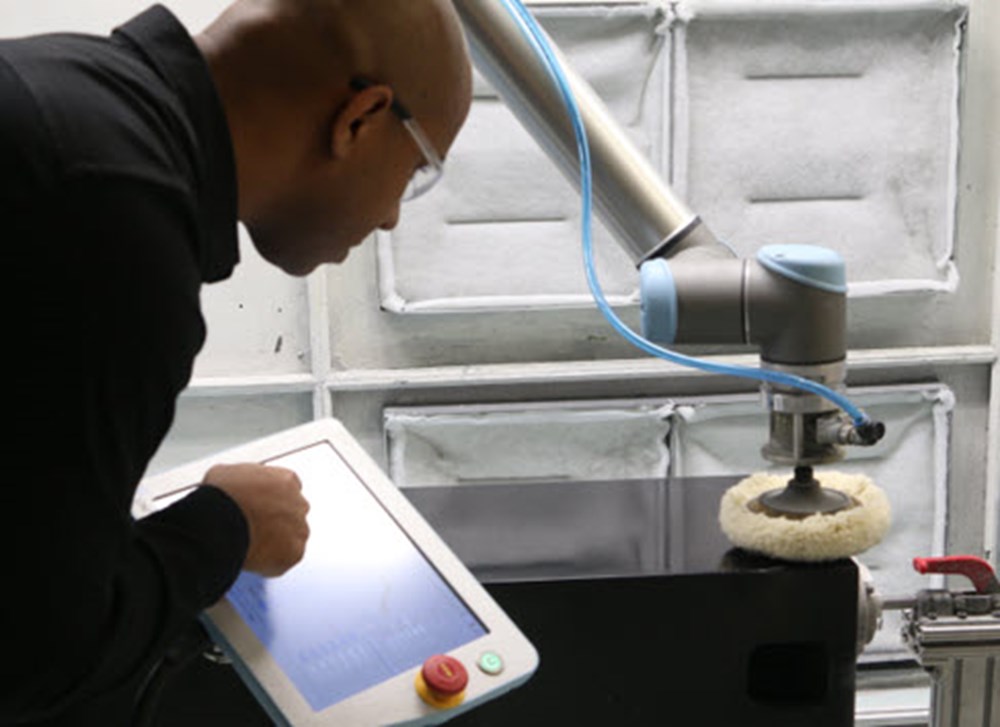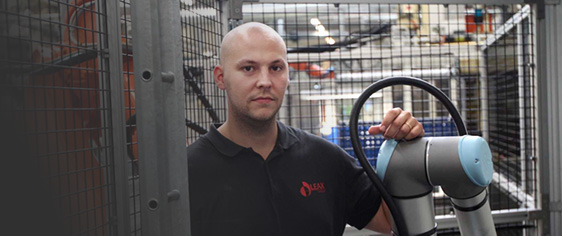Among the most cutting-edge developments of the 20th century are robotic arms. They are at the heart of the automation revolution. In this article, we will look at the robotic arm mechanism and how a servo motor works for a robotic arm.
A robot is a virtually intelligent agent that can complete tasks robotically with some guidance. A robot is essentially an electro-mechanical device controlled by electronic and computer programming. There are three types of robots: autonomous, semi-autonomous, and remote-controlled.
Robots are best suited to perform dirty, dull and dangerous tasks which humans do not like to do. A robotic arm is a manipulator that mimics the actions of a human arm and is often programmable.
This robotic arm can be controlled and is programmable in nature. Because of how much it resembles a human hand, the robotic arm is frequently referred to as anthropomorphic. Today, all manufacturing-related jobs are completed by humans alone.
A robotic arm, however, may be used for many other operations, including welding, drilling, spraying, and many more. Mechanical and electrical engineering, control theory, computers, and even artificial intelligence are all used in robotics.
An essential goal in the development of robots is to have them interact with their surroundings. This contact is often established using a grasping arm or other end effectors. In the robotic arm, there are several joints in addition to the shoulder, elbow, and wrist, along with the finger joints. These joints are identical to those in a human arm.
The Five Components Of A Robotic Arm
Controllers
This functions as the brain of the robotic arm. The program that governs the entire robot is stored within the controller. A technician writes the code and inputs it into the controller. Depending on how sophisticated it is, certain processors may be autonomous. After being programmed, they complete the remaining tasks on their own. The types of controllers include basic ones like joysticks or complicated ones like those used in heavy industry.
Arms
The essential components of the robotic arm are those that also occupy the most room. Three components make up a robotic arm: a wrist, an elbow, and a shoulder. All of them are intended to function as joints, giving the arm considerable flexibility to move freely in any direction. It has the ability to rotate and spin in addition to moving forward, backward, up, and down. Together, the three components of the machine enable it to do the tasks for which it was created.
End Effector

This is the portion that most frequently appears as two claws and mimics fingers. The portion of the robotic arm performs the necessary gripping, tugging, lifting, and lowering actions. They may be incredibly powerful at times, lifting things that are heavier than the entire arm itself. They open and close on command. End effectors are extremely flexible and may travel in any direction while simultaneously spinning.
Drives
These are the motors that allow the robot arm's various components to move. They are situated in the space between the joints, and they move independently of one another at various speeds to drive the arm in whichever direction the controller requests. They rely on belts to move components as quickly or slowly as required.
Sensors
These sophisticated components of the robotic arm are in charge of figuring out the area around the robot. Robotic sensors can determine whether an obstruction is present nearby, and the information they transmit back to the controller enables the robotic arm to steer clear of collisions. This is how quickly robots can operate side by side with each other and nearby humans without an accident happening.
What Is Servo Mechanics In Robotics?
A specialised feedback-control mechanism is a servomechanism. Robots, motors, steering systems, and other mechanical devices are all controlled by servomechanisms.
Robotics makes considerable use of servomechanisms. A robot controller may instruct a servomechanism to move in certain ways based on sensor inputs. When connected together and directed by an advanced computer, many servomechanisms are capable of doing complicated tasks like cooking food.
A servo system is a collection of servomechanisms with related hardware and electronics that are designed to perform a particular purpose. Servo systems perform exacting and frequently repeated mechanical tasks.
A computer may control a servo system composed of several servomechanisms. For instance, a drone can be programmed to take off, fly a mission, come back, and land. Servo systems can be configured to perform assembly-line labour and other jobs that require precision, endurance, and repeated movement.
What Is A Servo Motor For A Robotic Arm?
A servo is a precise and effective way to transform rotational motion into linear motion at its most basic level. A servo motor for a robotic arm consists of:
- The electronic assembly is made up of a potentiometer, a controller board, and an AC or DC electric motor.
- The robot servo motor and other components are housed in the Case, which is made of plastic.
- Drive Gears convert the high-speed output of the robot servo motor into a lower speed, greater torque servo output.
- The last point of contact between the servo and the object of the motion it produces is the Output Spline, coupled to the output shaft.
The Working Of Servo Motors For A Robotic Arm
A motion controller sends a signal to the servo. The servo's rotation will vary depending on the input signal's pulse width modulation (PWM). The output spline of a servo is typically at 0° while it is at rest. The output spline will spin 90° in one direction at a pulse width of 1.5 milliseconds (ms), based on an anticipated pulse frequency of 20 milliseconds (ms).
The output spline will continue spinning 90° further to the 180° position with a pulse width of 2ms. The output spline rotates 180° backward to the 0° starting point with a pulse width of 1ms.
The potentiometer continuously monitors the output spline's location. The robot's servo motor's power is interrupted when the output spline reaches the required position, and the servo maintains that position unless instructed otherwise. A servo motor for a robotic arm will actively attempt to maintain a position when stopped in that position.
The proportional operation of servos is a crucial component. A robot servo motor will only rotate as quickly as is necessary to go from its current position to the position requested. A servo will spin extremely swiftly to reach the desired position if it is stopped at 180°, but has to be at 0°. The motor will revolve significantly more slowly to reach 0° if halted at a location that is already closer to it.
Benefits Of Servo Mechanisms In Robotics: Why Servo Motors For A Robotic Arm Are Used?
High-Torque Density
Advanced, quick servo-motors are required to provide the movement required to make a robotic arm quick and highly reactive. Torque is a term used to describe a rapid burst of energy used to produce swift motions. It is extremely high in robotic arms, which accounts for their extraordinarily high production efficiency.
Flexibility
Robotic arm motors are a trustworthy force in the production industry since each component may move independently of the others in all directions. The most sophisticated ones can rotate 360 degrees without snapping and have up to 6 degrees of flexibility. They are quick and adaptable enough to be employed for a variety of activities because of their independence.
High-Precision Control
For any machine, balancing speed and control is exceedingly difficult, yet robotic arm motors have mastered this through years of development. Modern programming used to operate robotic arms boosts speed without sacrificing precision. This is how they manage difficult things at incredible speeds without making any mistakes. The error margins are essentially nonexistent.
Programmable
Programmability is another feature that adds to the value of robotic arm motors. They cannot operate in a regular pattern since they are not fixed machines. Depending on the demands of the production process, changes may be made at any moment. With a simple program change, a robotic arm that picks up and loads may be converted to a welding robot and begin to move at a faster rate as if it has been doing it for years.
Durable
Robotic arm motors are made to last, and with proper upkeep, they may serve you for many years without expense. Considering the quantity of moving elements, a robotic arm is constructed using the correct materials to minimise damage. An average robotic arm has a guaranteed life of 35,000 hours of continuous use.
Safety
In contrast to popular belief, they are the safest equipment to have in your manufacturing facility. They can make precise split-second judgments based on the situation to avoid any type of accident because of cutting-edge technology like sensors. This is the cause of the substantial decline in accidents that have occurred in the industrial sector since automation became the norm.
Different Types Of Robotic Arms According To Movements Provided

- Cartesian Robots
- SCARA Robots
- Articulated Robots
- Cylindrical Robots
- Delta Robots
- Polar Robots
- Collaborative Robots
Most Common Applications Of Robot Servo Motor
Servo Motor in Robotics
Robotics is one of the most widely used servo motor applications. Think of a straightforward pick-and-place robot. A robotic device used to pick up an object from one location and deposit it in another is known as a "pick and place robot."
Servo motor robots are now employed to actuate the joints in order to take an object from position A and set it in location B. This is due to the fact that, in order to execute this pick-and-place assignment, we must plan the angular movement of every joint.
Servo Motor in Conveyors
In industrial production and assembling facilities, conveyors are used to move an object from one assembly station to another. Take the process of filling a bottle as an example. The bottle must be filled with the liquid before moving on to the next stage, which is mostly the packing stage.
In order to do this, conveyor belts with servo motor robots are employed. This allows the bottle to travel exactly to the right spot, stop, and then be filled with liquid before being directed to the next step. This procedure keeps on until it is halted. Therefore, the servo shaft's capacity to precisely regulate its position is useful.
Servo Motor in Cameras
Modern digital cameras are quite sophisticated. Its capacity to automatically concentrate on the subject of the photograph is one of its sophisticated characteristics. The camera's digital signal processor evaluates the object picture for sharpness once it has been generated.
In essence, the image seems blurry if the focal length (as determined by the camera lens) is incorrect. An extremely accurate servo motor robot installed within the camera performs the correction operation to the precise position of the lens so that the clearest image is taken. This is another significant use for servo motors.
Servo Motor in Robotic Vehicles
Servo motor robots are utilised in the wheels of modern robotic vehicles that are employed in both extremely complicated military and industrial applications. Since the servo being utilised is a continuous rotation servo, the angular movement is not significant in this case. What matters is the servo's capacity to provide enough torque to immediately advance the vehicle from a stop and then quickly stop it as well. The speed at which the vehicle should move can also be modified.
Servo Motor in Solar Tracking Systems
As society transitions to a clean and renewable energy system, solar power generation and utilisation are becoming more important. In the past, installed solar panels were static, remaining in the same place throughout the day. According to general science, the Sun's position in relation to the solar panel will fluctuate since it is not constantly looking in the same direction. This suggests that we are not getting the most energy possible from the sun by completely using its power.
Conclusion
We hope our readers now understand the robotic arm mechanism and the use of a servo motor for a robotic arm. As more technologies emerge, the process behind a robotic arm's operation becomes more complex.
The day will soon come when automation will be fully incorporated into every facet of manufacturing, to the point where robots will manage everything on their own. If you really want to purchase a robotic arm for yourself but are unsure which robot manufacturer to choose, visit our website and receive some advice.











